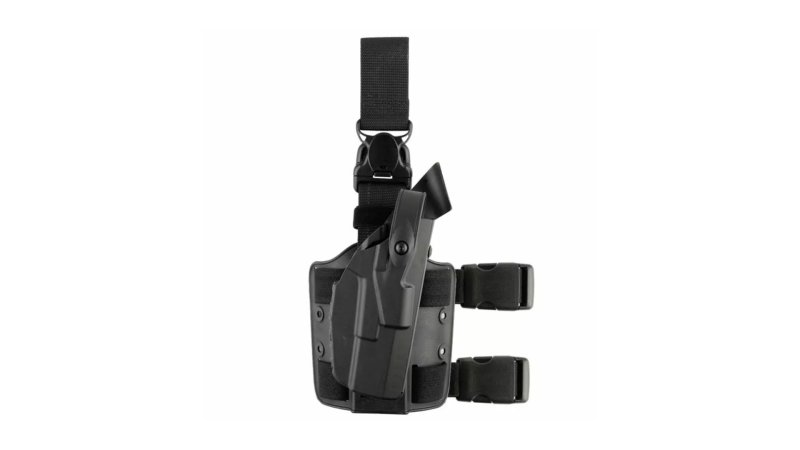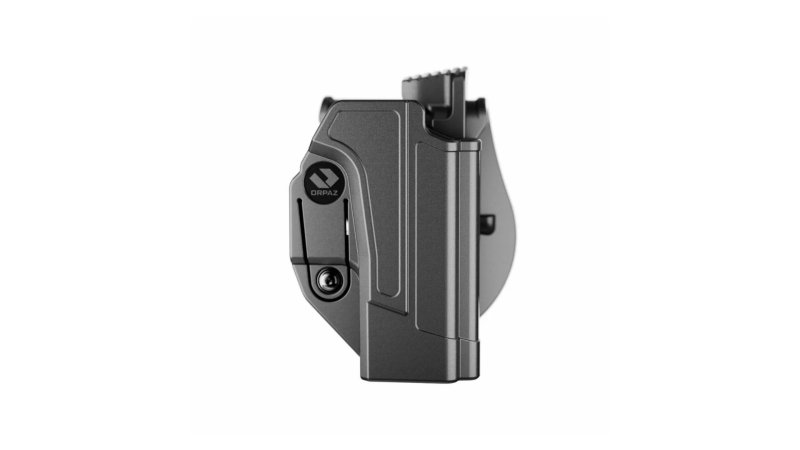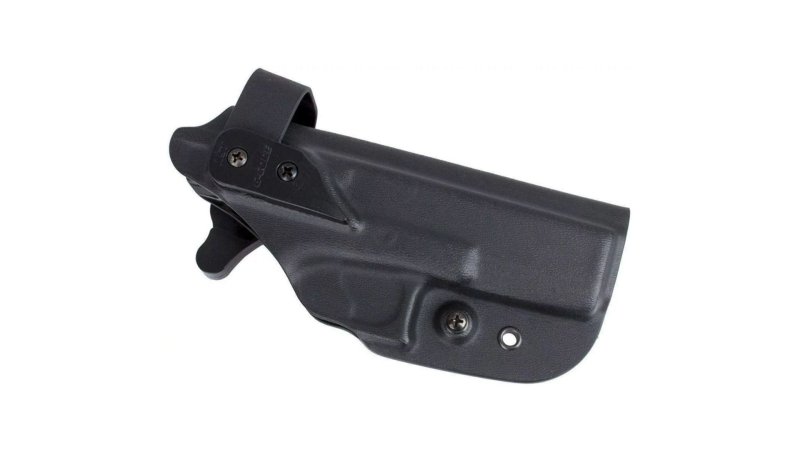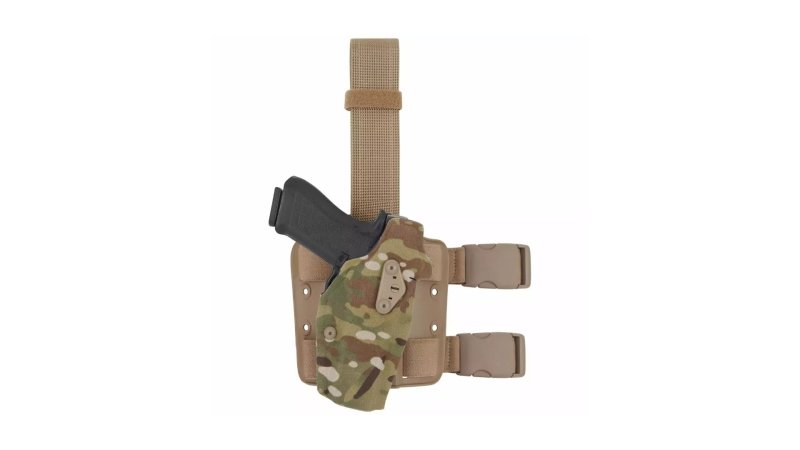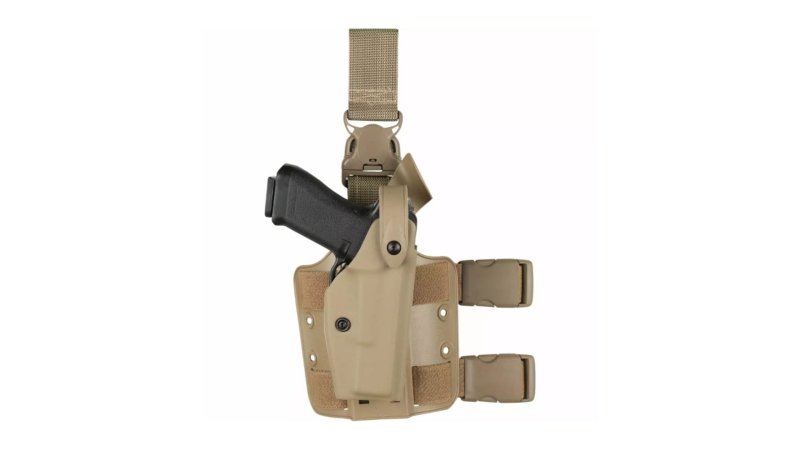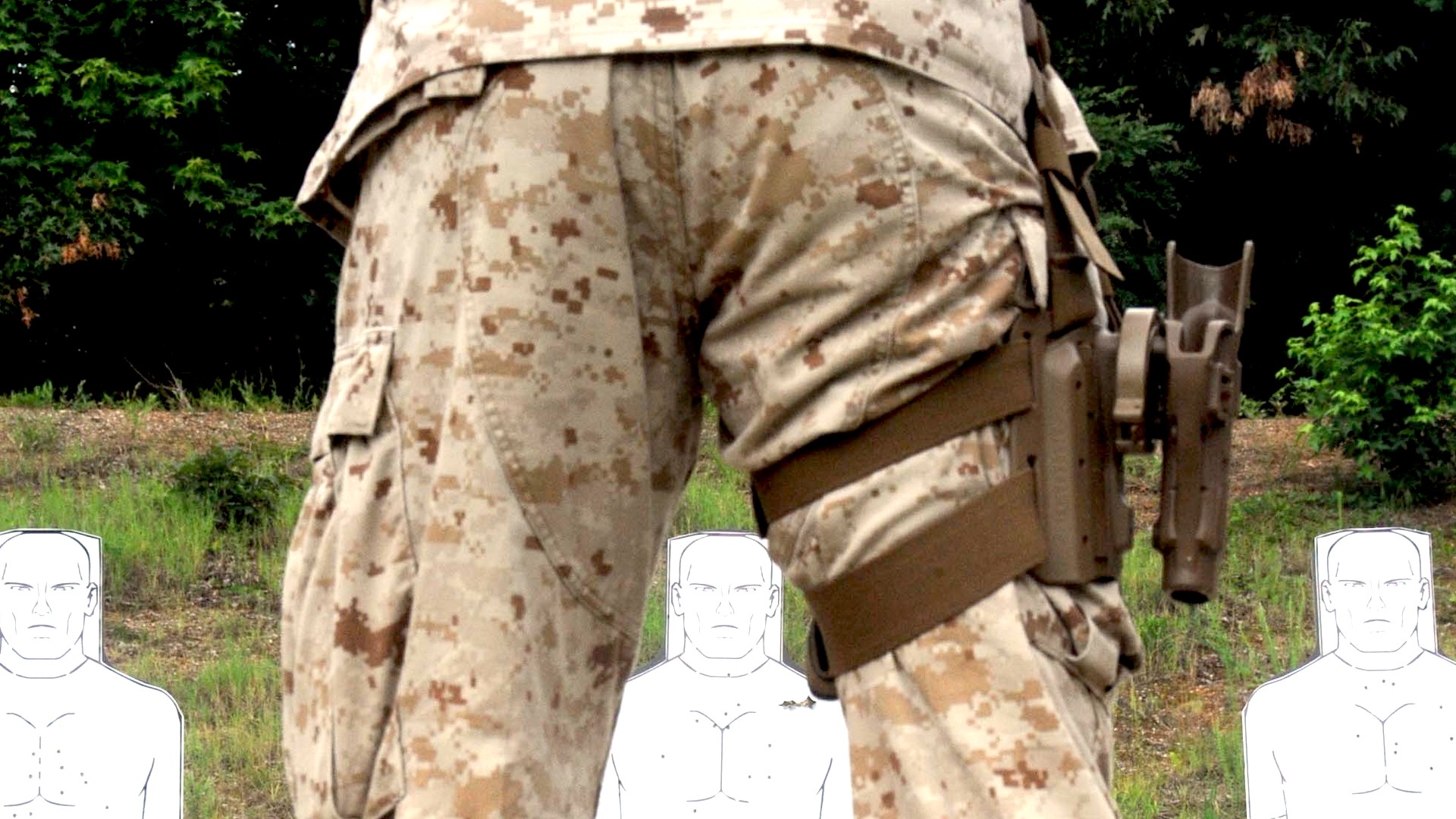

We may earn revenue from the products available on this page and participate in affiliate programs.
While the general public may think of Lara Croft cosplays and Hollywood action movies whenever they think of drop-leg holsters, the reality is that drop-leg holsters don’t just look tactical, they serve on the thighs of people in the most dangerous environments in the world today. By dropping the holster down from the gun belt to the thigh, more room is afforded for heavier body armor with side plates and pouches, plus freeing up some real estate on the belt itself for extra utility. Drop-leg holsters are about as overt as you can get, being preferred in high profile situations by everyone from Navy SEALS and British SAS to the FBI Hostage Rescue Team and SWAT teams the world over.
But what makes for a good drop-leg holster? In a market flooded by cheap nylon “universal holsters,” what rises to the top? How are they different from the conventional waist or CCW holsters besides carry position? And which will be crowned overall King of the Holsters and why? Let’s explore those questions in detail once and for all.
- Best Overall: Safariland 7005 7TS
- Best Value: Orpaz C-Series
- Honorable Mention: G-Code XST
- Best Optics-Ready: Safariland 6354DO
- Best Compatibility: Safariland 6005
- Best Nylon: Blackhawk Omega VI Elite
Methodology
As a veteran of a Coast Guard MSST Team and a lifelong firearms enthusiast, I’m very familiar with duty holsters. Both in my own unit and operating alongside other agencies — from local police departments to the Secret Service and FBI — Safariland was the gold standard for duty holsters (you might even say it was a safari of Safarilands). I used a Safariland 6005 with SLS for my Sig P229R DAK sidearm across countless deployments, boardings, and security zones, so I’m quite familiar with Safariland’s offerings on the market and know its reputation for dependability is well-earned.
I’ve also used a variety of holster brands over the years and stayed up to date on new developments in the industry. To be among the best drop-leg holsters, a large section of the cheap “universal” nylon holsters were eliminated, as they just don’t protect the firearm and trigger guard enough in the more exposed position of a drop-leg holster. This is not to say I didn’t consider a range of more entry-level options for the folks out there just starting their careers, and I was pleased to see there are good choices in the under-$100 category, too.
I tried to pick holster and platform combos that seemed most representative of what a manufacturer or holster style can offer, factoring as many additional options into the review as possible. To keep things consistent, I used a bog-standard Glock 19 for each holster, and I also stuck to production holsters that are broadly available. From there, I tested each holster for an extended period of time doing various non-firing activities as well as during a long-range day up in the mountains. I also ran retention drills and shooting exercises drawing from different positions, founded upon my military/LE training and experience.
For more information on the Task & Purpose methodology, visit our editorial guidelines to rest assured all featured products were well-tested.
Best Overall
Safariland 7005 7TS
Pros
- Lightweight yet durable
- Available with either the excellent SLS or ALS retention systems
- Excellent comfort and adjustability
- Wide variety of options and easy installation with QLS option
- Excellent debris and weather resistance
Cons
- Limited firearm compatibility
- Issues fitting threaded barrels
- QLS system adds bulk, if used
Product Specs
- Price: $200 to $245
- Retention: SLS locking hood; similar models available with ALS toggle or both SLS and ALS.
- Material: DuPont SafariSeven
Best Value
Orpaz C-Series
Pros
- Fully polymer construction for maximum protection
- Secure buckle and strap types, no creeping
- Good modularity with other Orpaz carry methods
- Solid performance at a fantastic price
Cons
- Pistol compatibility could be better
- Tip of the muzzle not fully protected by holster sidewalls
- Holster attachment process very inconvenient
- Some shifting of draw angle with a bump in the right place
Product Specs
- Price: $98 including drop-leg platform
- Retention: Level I or Level II, thumb lock release
- Material: Polymer
Honorable Mention
G-Code XST
Pros
- Modular from the ground up with amazingly easy interchangeability
- Fastest draw tested
- Combat-ready durability
- Flexible drop-leg strap aids mobility
- Accommodates suppressor-height sights and threaded barrels
- Good firearm compatibility
- Lifetime warranty
Cons
- Requires a bit more knowledgeable buyer
- Reliable usage requires practice
- No lighted options (though SOC line from G-CODE covers that need)
- Tight construction is good for keeping out debris, but can interfere with aftermarket parts or non-standard models (Ex: HK VP9 fits but VP9 Tactical requires modification)
Product Specs
- Price: $195 total for reviewed configuration
- Retention: Power-assisted retention canopy
- Material: Kydex with TacticalFuzz outer laminate
Best Optics-Ready
Safariland 6354DO
Pros
- Compatible with most common pistol-mounted optics right out of the box
- IR-reducing overwrap
- Slimmer optics shroud than other designs for a less bulky holster
- ALS system makes for a fast and smooth draw with no snags
Cons
- Only available for Glock pistols
- Pricey
Product Specs
- Price: $240 to $273
- Retention: ALS
- Material: SafariLaminate with Cordura overwrap
Best Compatibility
Safariland 6005
Pros
- Legendary durability and performance
- Compatible with a wide range of firearms
- Versatile and functional
Cons
- Same MSRP as updated models
- Heavier than the 7TS line, though not by much
- Suede lining requires a little extra cleaning after heavy sand or saltwater exposure
Product Specs
- Price: $199 to $245
- Retention: SLS or ALS in similar variants
- Material: SafariLaminate with suede liner
Best Nylon
Blackhawk Omega VI Elite
Pros
- Offers decent fit and firearm protection
- Fully adjustable single strap design
- Functional
Cons
- Nylon construction limits potential
- Thick hook-and-loop on drop-leg strap limits mobility
- Only moderate retention capabilities
- Extra retention options far too slow and cannot be removed without permanent cutting
Product Specs
- Price: $90
- Retention: Rear strap with thumb snap closure; optional hook-and-loop strap and pistol grip buckle
- Material: Nylon
Our verdict on drop-leg holsters
Drop-leg holsters are the go-to choice for high-profile missions where concealability is not a concern. This means dependability and safety are even more important than in other carry methods, as the firearm is more exposed and subject to greater motion, adding an active retention requirement.
Safariland has been the industry standard with its solid builds and fantastic SLS/ALS retention systems for a long time, earning the trust of security professionals around the world. G-Code has been steadily building a reputation for themselves, however, offering limitless customizability for high-end users. At the entry-level bracket, Orpaz offers the confidence and durability of full polymer construction with many features found at higher price points.
What to consider when buying a drop-leg holster
This review doesn’t cover every single drop-leg holster out there. Safariland alone has a tremendous variety of different models and variants. Add to that the modularity of modern holsters, and things can get confusing for potential buyers very quickly. However, here’s where to start when evaluating drop-leg holsters for yourself.
Safety
Any good holster will always protect the trigger from accidental manipulation. Look for holsters that completely protect the trigger from stray fingers, twigs, fence wires, or anything else that might sneak in. This is also why I don’t recommend nylon holsters, as the more exposed carry position means there’s a lot more potential for a soft holster to be pressed against the trigger or punctured.
Retention
Active retention (also called Level II or above) is a must for a drop-leg holster. Not only is the holster more exposed where grabby hands can try for some unauthorized access, but the thigh position is subject to a lot more motion during walking, running, climbing ladders, jumping fences, etc. The simple act of getting out of a car can see your pistol grip snag on a seat or seat belt. Active retention should be secure enough that it will delay an attacker from drawing your pistol while you deploy retention drills you’ve trained for, but also be easy enough to use that draw times are competitive with passive retention draws while under stress.
Fit
Make sure the firearm is snug and well-supported. It should not rattle in the holster and the drop-leg platform should not flop around or move out of position when you’re in motion. The platform should be easily adjustable to a position on your thigh where you can easily draw your pistol, but low enough that you clear whatever body armor or side pouches you run naturally. Also consider you may have to draw while seated, laying prone, or in other awkward positions.
Durability
When squeezed or flexed with just your hands, the holster should stay secure to the drop-leg platform. Some flexing is alright, but if the holster feels like it’s straining to hold onto the platform, that’s not a good sign. Consider not only your routine motions, but also if you have to go to ground with a suspect or belly crawl across the terrain. The muzzle end of the holster should also be open to allow any debris or moisture to fall out.
Modularity
Many holster brands allow the user to transfer the holster to different carry methods or add to/modify the carry platform. Consider the product’s ecosystem when shopping and how easy it is to change the holster or platform’s setup. It makes a lot more sense to buy one holster that’s a little pricier but can easily transfer between your needs, versus buying two separate holsters. Some attachment systems are even compatible between brands, so a little research goes a long way to saving you money.
Pricing considerations for drop-leg holsters
Budget
The budget bracket (under $100) for drop-leg holsters is awash with cheap “universal” nylon holsters that are really only designed to hold the gun and deployment of the weapon is a secondary consideration. However, there are effective options hidden amongst all the muck. Look for something specifically designed for your gun to ensure the best fit and protection while making sure active retention is included.
Mid-range
Mid-range ($100 to $200) is a little tricky to define for drop-leg holsters since the holster and the platform it attaches to can be offered separately and at different price points. Most modern holsters offer good protection for the firearm and trigger guard, but be sure to keep in mind active retention and a good attachment system to the drop-leg platform. The platform itself should be comfortable, secure, and fully adjustable for ride height and thigh tightness. If the holster-platform attachment system is quickly detachable, better yet,so you can use the same holster in different loadouts.
Premium
The premium price bracket (over $200) includes some of the best names in the business, as well as some mid-grade brands with extra options included (light-bearing holsters, optics-ready holsters, easily swappable attachment systems, etc). These will often include really slick retention systems, specialized coatings and finishes, fantastic modularity and superb durability. Premium drop-leg holsters will not only offer the most secure and comfortable fit, but also the fastest draw times and best interoperability with other tactical gear.
FAQs about drop-leg holsters
Q: What is the purpose of a drop-leg holster?
A: A drop-leg holster shifts the pistol down onto the upper- to mid-thigh so bulky body armor with side plates and/or pouches don’t interfere with drawing your pistol.
Q: Can you open-carry with a drop-leg holster?
A: Yes, provided you are legally allowed to open-carry, drop-leg holsters are excellent for the task.
Q: Are drop-leg holsters legal in the USA?
A: Yes, provided you are in a jurisdiction that allows you to open-carry or are a suitable exemption (e.g., police officer, at a range, etc).
Q: What holsters does the FBI use?
A: Not to be confused with the “FBI cant,” which just refers to a particular holster angle, the FBI mostly uses common law enforcement holsters like Safariland, Bianchi, and Blackhawk brands. The famous Hostage Rescue Team and other tactical components of the FBI generally prefer Safariland holsters.
